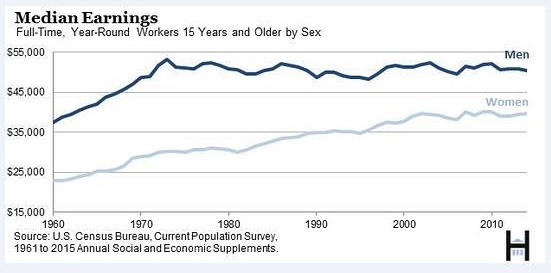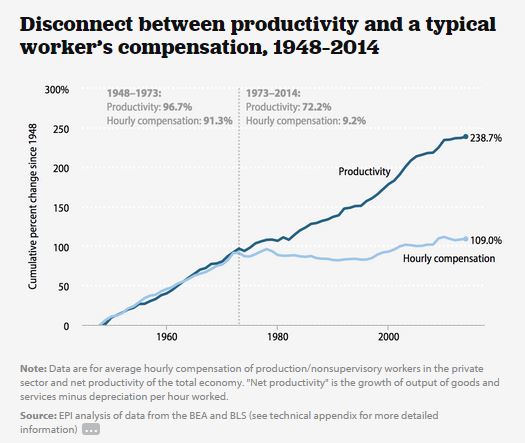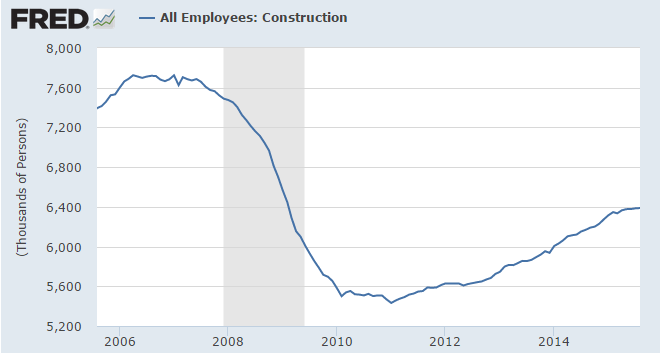Wage Apocalypse for the American man: Typical male worker earned less in 2014 than in 1973.
- 3 Comment
The middle class destruction train is moving full steam ahead if we are to examine Census figures closely. And the American male has a first-class ticket on this express train to wage destruction. According to the recently released Census figures full-time working males are earning less than they did in 1973 adjusting for inflation. Purchasing power matters greatly even though there is this ongoing narrative that we are experiencing very little inflation. Has anyone taken a look at housing costs, healthcare costs, or even college tuition? The problem at the core of this salary stagnation is that productivity gains are simply not trickling down to the typical worker. The Great Recession largely smashed male employment. Males lost 3 out of 4 jobs in the Great Recession. The financial crisis impacted everyone, male and female, but there is some interesting data to be examined from the figures for full-time working males.
Recession impact on males
One of the caveats I will begin with is that the typical (median) American household earns about $52,000 per year. This is important to note because we have a massive number of Americans working in part-time jobs and also, low-wage fields.
What we will examine below is for full-time male workers (meaning fully employed year round). Take a look at this chart first:
The typical full-time working male is earning less than he did in 1973. In 1973 a man with a full-time job was earning $53,294 measured in 2014 dollars. The latest Census data finds that a full-time working man today is making $50,383. Keep in mind this is for those that actually have a job. We have more than 94 million Americans that are “not in the labor force†a record by any measure.
The pay gap for women is still large but the median female worker saw their pay increase by more than 30% between 1973 and 2014 from $39,621 to $30,182. This is largely driven by the gains made in educational attainment. Of course the challenge today for both men and women is finding a good college education that won’t put you into massive student debt.
What is going on here? One major contributing factor is that productivity gains are simply not being passed on to workers:
While output per hour of work is up nearly 2.5 times wages are simply not keeping track. Part of the issue is that there is a growing income inequality in the nation. This is simply a fact. We have a larger financier class in the economy that depends on economic rents.
Take for example large investment banks. They use their financial power to buy politicians to bend the rules to their favor. This allowed many of them to garner lucrative bailout deals that ultimately made real world impacts. For example, many large banks used nearly free money (in terms of interest rates) to borrow and bought up a large number of single family homes. Many of these homes were bought at discount from families in the midst of foreclosure. Now, these homes are increasing in value on short supply and rents are being hiked up while incomes are stagnant. No real true economic gains are had here really – just shuffling money from the productive class to the rentier class. Those too big to fail banks? They are now much larger.
The housing crisis really impacted men as well. Good construction jobs were smashed as the housing crisis unfolded. We have a demand for affordable homes but builders realize that the whims of the banking system can shift very quickly and younger Americans are not in a position to buy. Just look at construction jobs in the US:
We are down 1.3 million construction jobs since the peak construction boom. Instead of better paying jobs growing, we are seeing more low-wage labor dominating the marketplace. The economy is sending males back into the past of 1973 when it comes to wages.
If you enjoyed this post click here to subscribe to a complete feed and stay up to date with today’s challenging market!3 Comments on this post
Trackbacks
-
laura m. said:
With all these facts on wages and the fact inflation for basic necessities is high, I don’t see how anyone can start a family or even want to if both man and wife must work, Babysitters aren’t cheap either. America’s future is minus zero, also in ref. to article on working way past retirement age till you drop dead. The middle class destruction is planned.
October 2nd, 2015 at 10:30 am -
Beano said:
Earned less but you sure can buy more. Nobody has cars, houses, appliances and computers like today.
October 2nd, 2015 at 6:59 pm -
R&E said:
some food for thought and a question.
1960’s..
gas 25c/gal
Min wage $2.50
new camaro $2500.00
build a house for $25000.00
Today..
gas $2.50
new car $25000.00
average new home nationwide $250000.00SO! … how are we so comfortable for not having $25.00/hour wages?
Answer.. In the 60’s we imported aprx 10% from a cheap country named Japan – we manufactured the rest here on our economy.Today we import 90% from every country the World Bankers say will be the losers and we are living the “Life of Bryan” on their backs.
How long will the rest of the world let us do this?
October 5th, 2015 at 3:56 am



 If you enjoyed this post click here to subscribe to a complete feed and stay up to date with today’s challenging market!Â
If you enjoyed this post click here to subscribe to a complete feed and stay up to date with today’s challenging market!Â